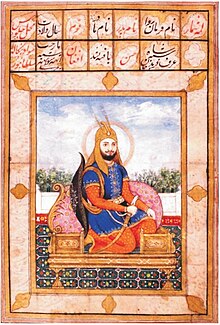
Back شير شاه Arabic شير شاه ARZ Şir şah Suri Azerbaijani شیرشاه سوری AZB शेर शाह सूरी Bihari শের শাহ সুরি Bengali/Bangla Xer-Xah Surí Catalan شیر شا سوری CKB Šér Chán Súr Czech Sher Shah Suri German
| Sher Shah Suri | |
|---|---|
| Shah Sultan Adil Ustad-I-Badshahan[a] Hazrat-i-Ala Lion King | |
 Painting of Sher Shah Suri from a manuscript of Tarikh-i-Khandan-i-Timuriya (dated between c. 1570–1590), prepared by the court painters of Mughal emperor Akbar | |
| Sultan of Hindustan | |
| Reign | 6 April 1538/17 May 1540 — 22 May 1545[b] |
| Coronation | First coronation: 6 April 1538 Second coronation: 17 May 1540 |
| Predecessor | Humayun (as Mughal Emperor) |
| Successor | Islam Shah Suri |
| Ruler of Bihar | |
| Reign | 1530 — 6 April 1538/17 May 1540 |
| Predecessor | Jalal Khan Lohani |
| Successor | Abolished |
| Born | Farid al-Din Khan 1472 or 1486 Sasaram, Delhi Sultanate |
| Died | 22 May 1545 (aged 73 or 59) Kalinjar |
| Burial | Sher Shah Suri Tomb, Sasaram |
| Spouse | Lad Malika |
| Issue | Islam Shah Suri (Jalal Khan) Adil Khan Qutb Khan |
| House | Sur |
| Father | Hasan Khan Sur |
| Religion | Sunni Islam |
Sher Shah Suri (Farid al-Din Khan; 1472 or 1486 – 22 May 1545),[1] also known by his title Sultan Adil (lit. 'the Just King'), was the ruler of Bihar from 1530 to 1540, and Sultan of Hindustan from 1540 until his death in 1545.[2] He defeated the Mughal Empire, founding the Sur Empire and establishing his rule in Delhi. The influence of his innovations and reforms extended far beyond his brief reign. During his time in power, he remained undefeated in battle and was renowned as one of the most skillful Afghan generals in history.[3] By the end of his reign, his empire covered nearly the entirety of Northern India.
Born between 1472 and 1486 and given the name Farid Khan, his early childhood saw him flee from home due to internal family strife. He pursued an education in Jaunpur, where his rise to power began after his father offered him a managerial position over his jagirs. Sher Shah effectively governed these territories, gaining a reputation for his reforms that brought prosperity to the region. However, due to family intrigues, he eventually relinquished his position over the jagirs. Sher Shah then moved to Agra, where he stayed until his father's death. This event allowed him to return to his family's jagirs and take control, thereby solidifying his leadership and furthering his rise to power.
Sher Shah spent time in Agra after the Mughals gained power, observing the leadership of Babur. After leaving Agra, he entered the service of the governor of Bihar. Following the governor's death in 1528, Sher Shah obtained a high position in Bihar and, by 1530, became the regent and de facto ruler of the kingdom. He engaged in conflicts with the local nobility and the Sultanate of Bengal. In 1538, while Mughal Emperor Humayun was engaged in military campaigns elsewhere, Sher Shah overran the Bengal Sultanate and established the Suri dynasty. He defeated the Mughals and drove them out of India, establishing himself as emperor in Delhi. Sher Shah led numerous military campaigns against his neighbors, conquering Punjab, Malwa, Marwar, Mewar, and Bundelkhand. A brilliant strategist, Sher Shah was both a gifted administrator and a capable general. His reorganization of the empire and strategic innovations laid the foundations for future Mughal emperors, notably Akbar. Sher Shah died in May 1545 while besieging Kalinjar fort. Following his death, the empire descended into civil war until it was eventually re-conquered by the Mughals.
During his rule as Emperor of the Sur Empire, Sher Shah implemented numerous economic, administrative, and military reforms. He issued the first Rupiya organized the postal system of the Indian subcontinent, as well as extending the Grand Trunk Road from Chittagong in Bengal to Kabul in Afghanistan, significantly improving trade. Sher Shah further developed Humayun's Dina-panah city, renaming it Shergarh, and revived the historical city of Pataliputra, which had been in decline since the 7th century CE, as Patna.[4] Additionally, he embarked on several military campaigns that restored Afghan prominence in India.
Cite error: There are <ref group=lower-alpha> tags or {{efn}} templates on this page, but the references will not show without a {{reflist|group=lower-alpha}} template or {{notelist}} template (see the help page).
- ^ Lee 2019, p. 55.
- ^ Kolff 2002, p. 33.
- ^ Chandra 2007, p. 216.
- ^ Patna encyclopedia.com.